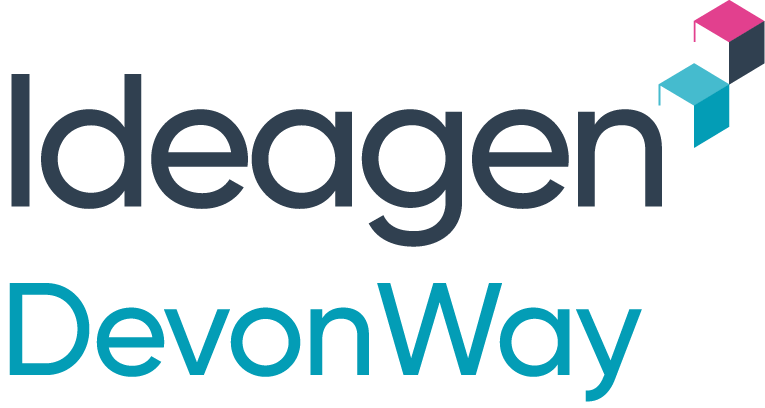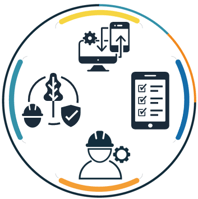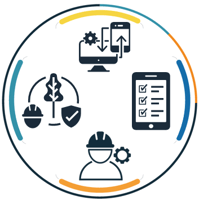
Enterprise Asset Management systems are essential to any organization that depends on assets, equipment, and other physical resources to successfully conduct its business. Having software in place to not only balance cost, opportunity, and risk against asset performance but also to integrate your critical processes are key to ensuring your business is running safely, reliably, and profitably.
DevonWay Enterprise Asset Management (EAM) software connects your operational and work management processes so that you can identify, plan, schedule, execute, analyze, and improve asset reliability and work execution. Enterprise Asset Management helps you balance costs, opportunities, and risks against asset performance to achieve your organizational objectives. Work management is the foundational process that all EAM systems use to maintain assets.
The Plan-Do-Check-Adjust (PDCA) cycle is an iterative four-step management method for controlling and continuously improving asset management processes and products. Below is an illustration of the Plan-Do-Check-Adjust process that shows the primary steps of the DevonWay Enterprise Asset Management system.
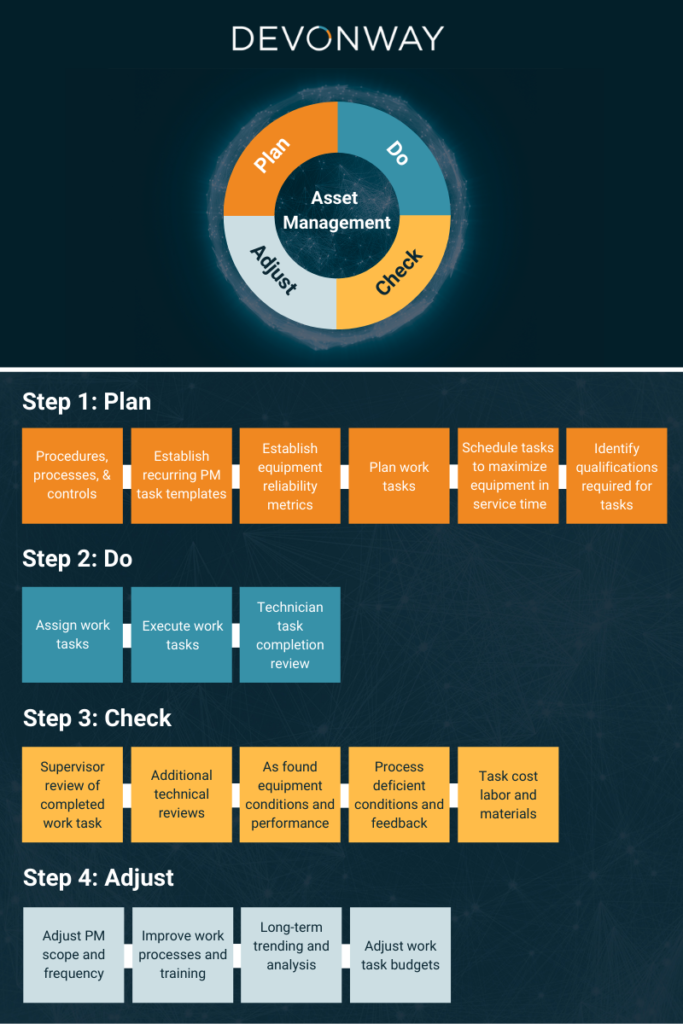
Here’s how it works in DevonWay Enterprise Asset Management.
Step 1: Plan
Several DevonWay products can kick off the Plan phase: Mobile Work Packages, Document Management, Work Orders and Tasks, Work Permits, and Work Planning and Scheduling.
You establish Equipment Reliability criteria and equipment and process Key Performance Indicators (KPIs) to enable EAM system performance monitoring throughout the PDCA cycle.
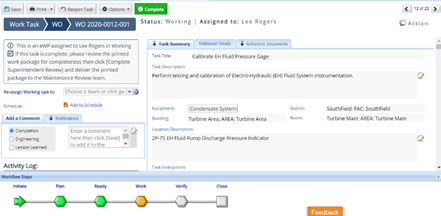
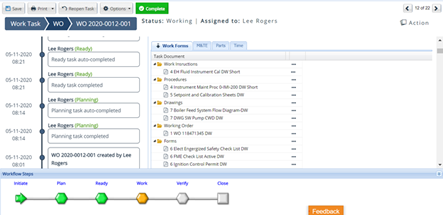
The output of the plan phase is an electronic work package that contains all the information that a technician needs to execute tasks safely, correctly, and efficiently.
Step 2: Do
“Do” starts with the supervisor assigning work tasks (mobile work packages) to properly trained and qualified technicians. Technicians perform a pre-job brief, obtain permits to ensure equipment is safe to work on, and acquire maintenance and test equipment (M&TE). This includes performing work, such as calibrating instruments and then documenting work performed, parts used, and labor hours.
A significant gap in first and second generation legacy EAM systems is that that the “Do” phase was based on inefficient paper processes. DevonWay EAM uses a fully digital Mobile Work Package process throughout the entire work execution lifecycle.
With DevonWay, you can fully integrate Mobile Documents with Mobile Work Packages to create Smart Documents and Procedures. This reduces human performance execution errors and ensures conformance to company-specific procedure use and adherence expectations.
DevonWay Smart Procedures features include data validation, automated branching, sequential place keeping and hold points, and electronic submission of field data to server data systems. Smart documents are dynamic, so the fields are automatically updated via communication with other enterprise databases.
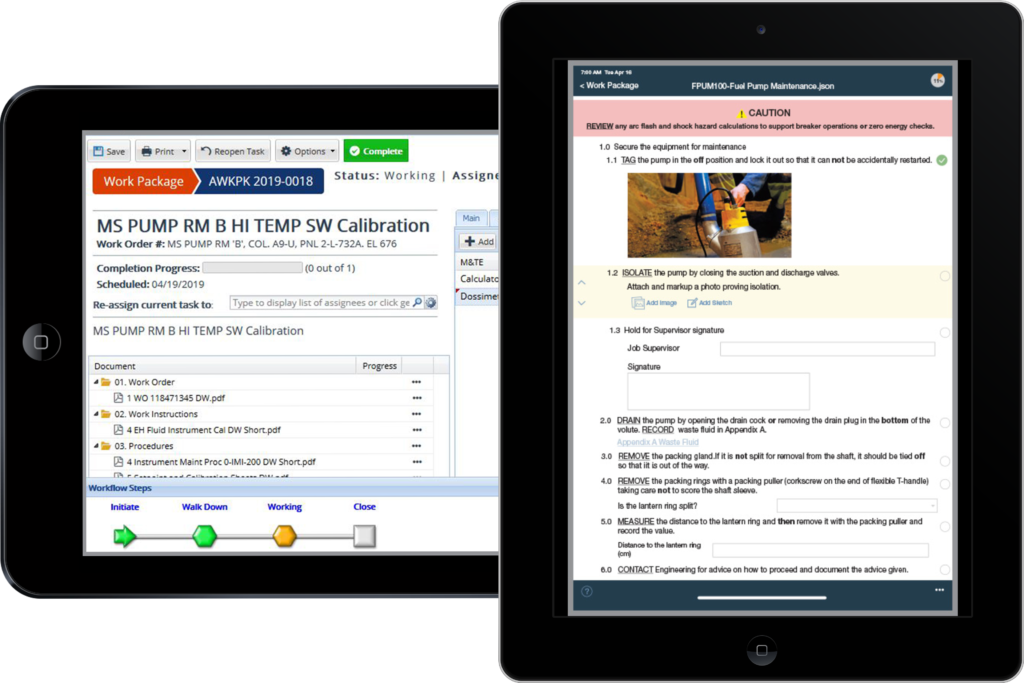
While performing work tasks, technicians use Mobile Work Packages to 1) document equipment conditions and deficiencies, 2) collect equipment reliability and condition data, and 3) provide recommendations for PM program changes, procedures, and work management process improvements. Once the work is finished, they submit the completed work package to their supervisor.
Observation activities are a core aspect of any business that values continuous improvement. While technicians are in the process of executing work tasks, management, supervisors, and quality assurance personnel can perform work task observations using the DevonWay Mobile Observations application. Real-time mobile observations provide a means to proactively recognize and reward good behaviors and reveal opportunities for improvement or deficiencies at the time of task execution.
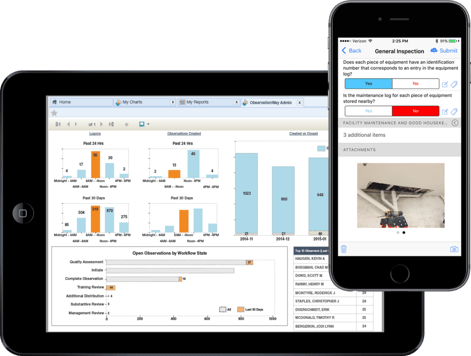
If the unthinkable happens and someone gets injured, the DevonWay Accidents and Injury Reports application allows you to quickly and easily document the event so future mishaps can be avoided. Event reports are automatically generated directly from the system to help maintain compliance with OSHA 300 and 301, which reduces the administrative burden on the organization to create these reports.
Step 3: Check
After the work is completed, a supervisor uses the Mobile Work Packages desktop application to electronically review the completed work package documentation, verify the task has been completed properly, ensure that all acceptance criteria are met, and check that Post Maintenance Testing (PMT) is satisfactory. As-found equipment conditions and performance documented by the technicians will be reviewed to determine if equipment program change recommendations should be initiated.
Deficiencies may be identified during the work execution that require follow-up actions and can be documented using the mobile device at the job site using the appropriate DevonWay Corrective and Preventative Actions, Non-Conformance Reports, Lessons Learned, or Employee Suggestions applications.
Some specialized work tasks may require additional technical or administrative reviews and follow-up actions, in which case the supervisor will electronically transmit the work package for further reviews. During these additional reviews, the status and whereabouts of the work package is electronically tracked for full transparency.
Each work order task collects actual total labor and material costs associated with performing the task. This actual cost is compared to the expected work task cost to determine if these expenditures are within acceptable budgeted tolerances. If a significant cost gap exists, additional analysis to determine the reasons for the cost gap will occur. Potential follow-up to resolve the gap can be initiated using DevonWay Quality Management applications.
Step 4: Adjust
The Adjust part of the PDCA cycle implements approved changes identified during the Plan, Do, and Check process steps. These approved changes are usually the outcome of specific task deficiencies or feedback documented using DevonWay Mobile Work Packages, Corrective and Preventative Actions, Non-Conformance Reports, Lessons Learned, or Employee Suggestions applications.
Examples of typical changes include adjustments to:
- PM scope and frequency
- Work order task reserved parts
- Training programs
- Technical procedures/work instructions
- Processes or administrative procedures
- Work package contents
- Permit content and scope
- Asset/equipment operating practices
- Asset/equipment monitoring data
- Parts and labor estimates
- Work task budgets
- Inventory stocking levels
- Task resources and schedule durations
In addition to enabling adjustments based on individual tasks, DevonWay applications such as Business Intelligence, Universal Trending, and Operating Experiences enable further analysis to identify additional improvements.
At the end of the Adjust phase, actions implemented should be in place with the expectation that they are incorporated into the next Plan-Do cycle.
To learn more about DevonWay Mobile Work Execution and Enterprise Asset Management solutions, download our case study.
Related Posts
Choosing the Best Fit for Your Company: EAM or CMMS
When it comes to managing your business’s high value assets, you want to be sure to choose the...
Independent Research Firm Publishes Case Study on DevonWay EHS, QMS, and Asset Management Solutions
Verdantix, an independent UK-based research and consulting firm with expertise in environmental,...
What are Mobile Work Packages? Definition, Benefits, and Demo
What are mobile work packages? Mobile work packages provide work instructions and up-to-date...

